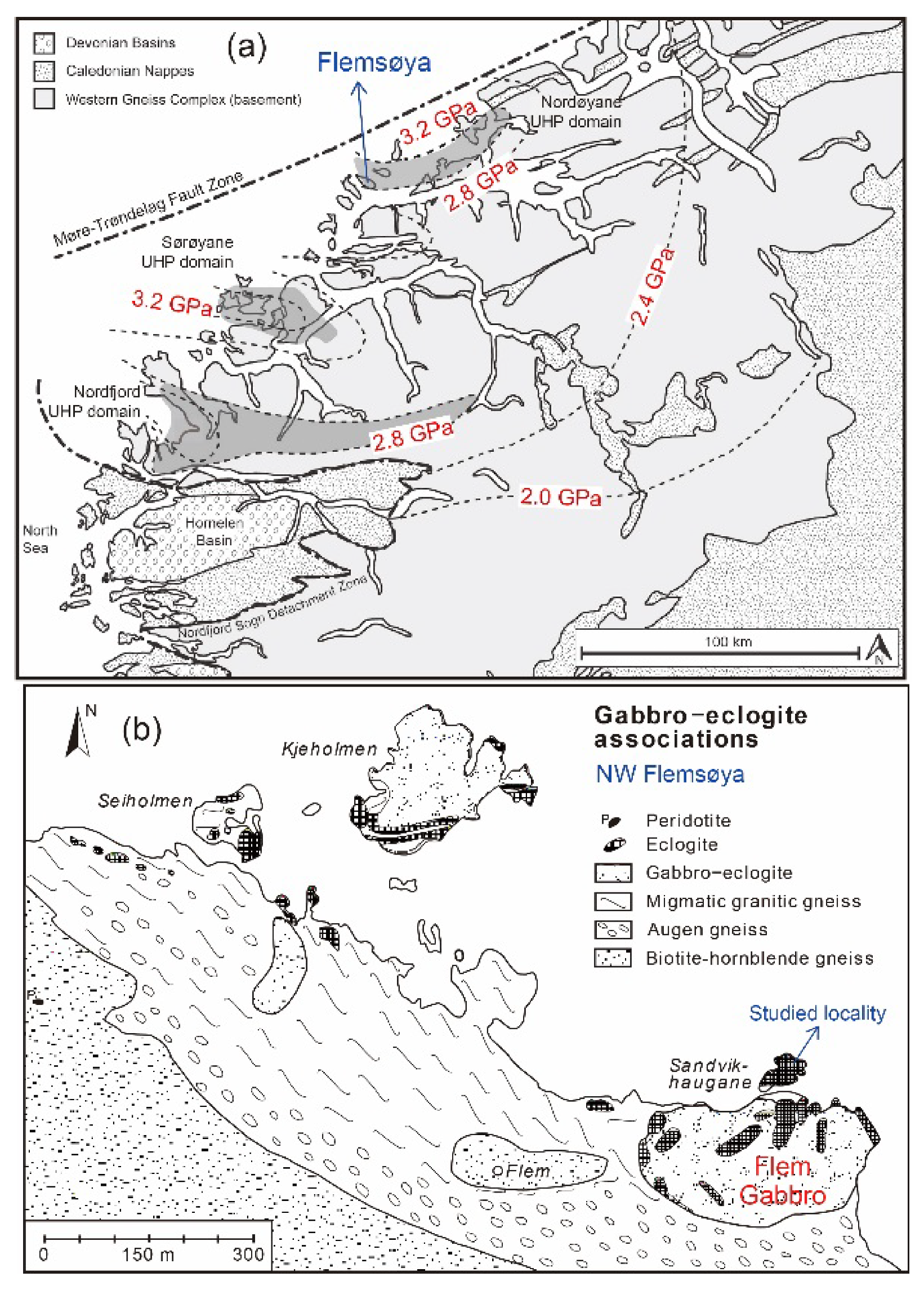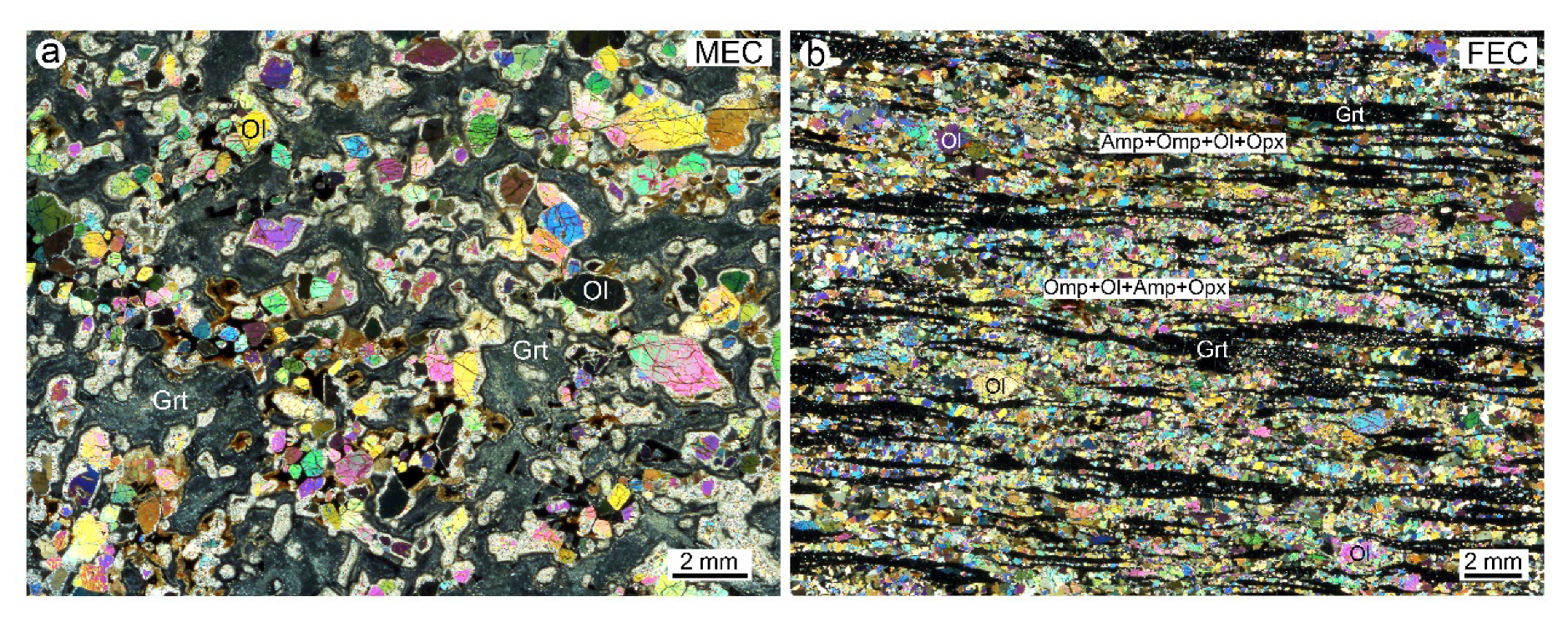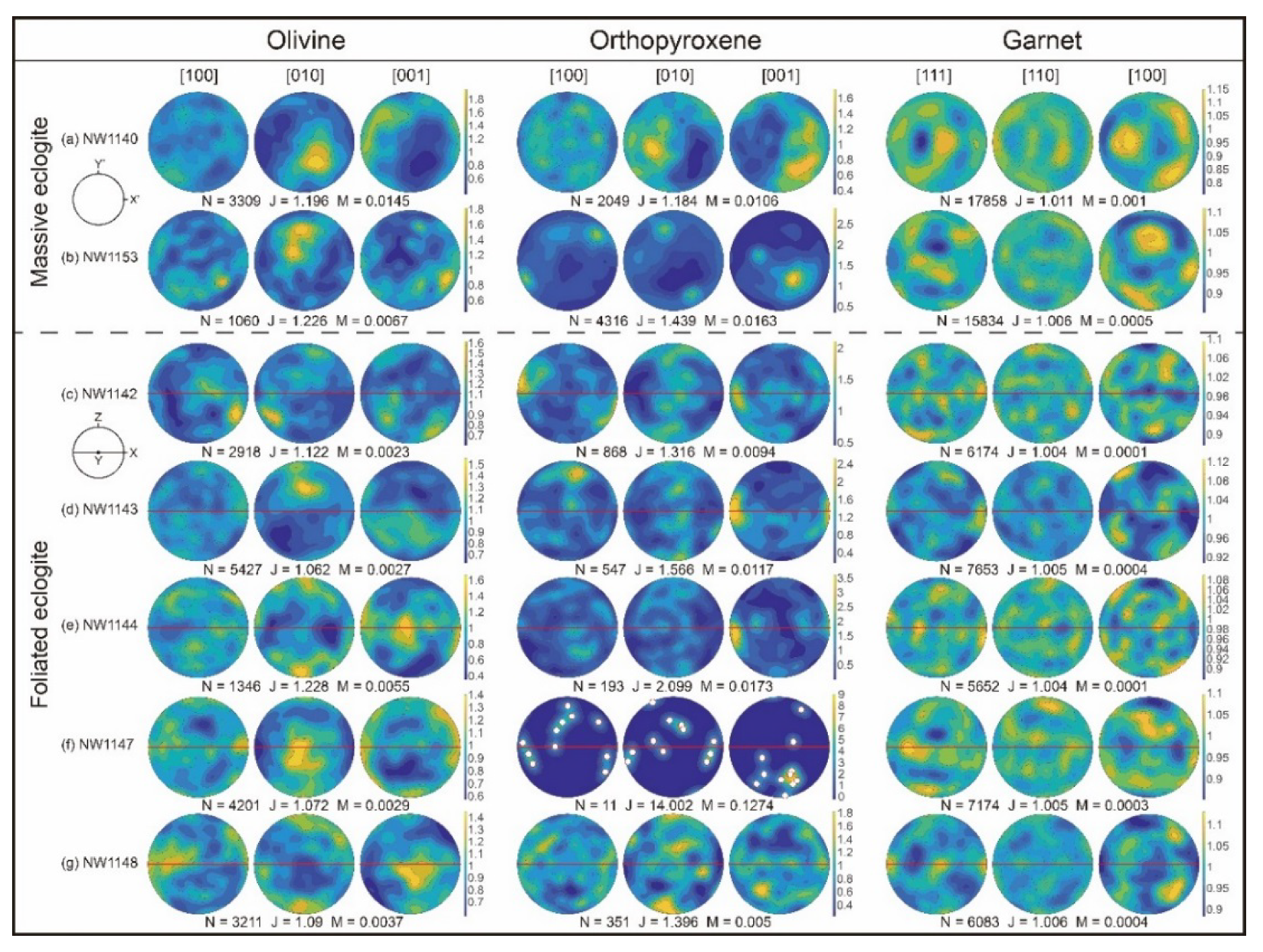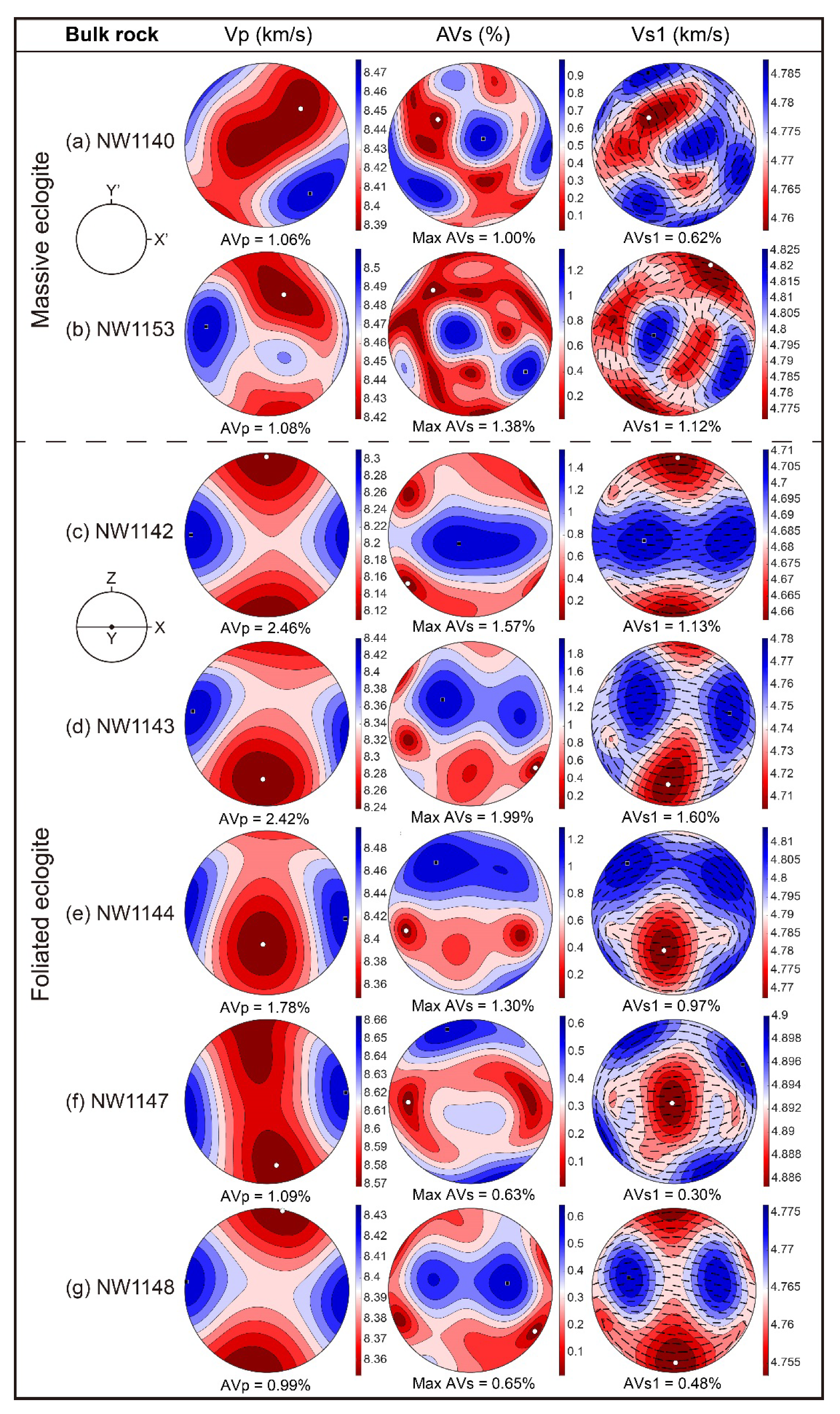Seismic Properties of a Unique Olivine-Rich Eclogite in the Western Gneiss Region, Norway
Abstract
1. Introduction
2. Geological Background
3. Samples and Methods
3.1. Sample Descriptions
3.2. Crystal-Preferred Orientation (CPO) Measurement and Analysis
3.3. Seismic Property Calculation
4. Results
4.1. Crystal-Preferred Orientation
4.2. Seismic Properties
4.2.1. Olivine Polycrystals
4.2.2. Orthopyroxene Polycrystals
4.2.3. Garnet Polycrystals
4.2.4. Omphacite Polycrystals
4.2.5. Amphibole Polycrystals
4.2.6. Bulk Rocks
5. Discussion and Implications
5.1. Factors Controlling the Seismic Anisotropy of Flem Eclogite
5.2. Seismic Properties and the Implications of Flem Eclogite
6. Conclusions
- The seismic anisotropies of the Flem eclogite were largely controlled by the CPO strength and significant destructive effects of CPO interactions on weakening the seismic anisotropies were manifested in both weakly and strongly foliated eclogite. Amphibole CPOs were the main contributors to the higher seismic anisotropies in some amphibole-rich and strongly foliated eclogite.
- The average seismic velocities correlated positively with the rock density and omphacite content, but negatively with the amphibole volume proportion, which is indicative of the dominant role of a mineral assemblage in governing the bulk rock seismic velocities.
- The Vp/Vs ratios were almost constant (≈1.765) between the Flem eclogite samples. These values were similar to the Vp/Vs ratios of peridotite and slightly higher than the dry eclogite that was free of olivine, suggesting that the abundance of olivine was the source of their high Vp/Vs ratios.
- Compared to other common rock types, including hydrous-phase-bearing eclogite, blueschist, peridotite, and gabbro, the AVp and max. AVs of Flem eclogite were very low and similar to those of dry eclogite. In contrast, the average Vp and Vs of the Flem eclogite were remarkably larger than the hydrous-phase-bearing eclogite, blueschist, and gabbro, but lower than the dry eclogite and peridotite. The Vp/Vs ratios of the Flem eclogite were relatively higher than those of dry, non-retrograded, and retrograded eclogite, but significantly lower than gabbro. These results thus highlight the feasibilities of utilizing seismic anisotropies, velocities, and Vp/Vs ratios for differentiating olivine-rich eclogite (e.g., Flem eclogite) bodies from their country rocks (e.g., gabbro) in the deep continental crust or subduction channel when high-resolution seismic wave data are available.
Supplementary Materials
Author Contributions
Funding
Acknowledgments
Conflicts of Interest
References
- Godard, G. Eclogites and their geodynamic interpretation: A history. J. Geodyn. 2001, 32, 165–203. [Google Scholar] [CrossRef]
- Austrheim, H. Fluid and deformation induced metamorphic processes around Moho beneath continent collision zones: Examples from the exposed root zone of the Caledonian mountain belt, W-Norway. Tectonophysics 2013, 609, 620–635. [Google Scholar] [CrossRef]
- Peacock, S.M. The importance of blueschist—Eclogite dehydration reactions in subducting oceanic crust. Geol. Soc. Am. Bull. 1993, 105, 684–694. [Google Scholar] [CrossRef]
- Carswell, D.A. Eclogite Facies Rocks; Springer: Heidelberg, The Netherlands, 1990. [Google Scholar]
- Liou, J.G.; Zhang, R.Y.; Ernst, W.G.; Rumble, D.; Maruyama, S. High-pressure minerals from deeply subducted metamorphic rocks. Rev. Mineral. Geochem. 1998, 37, 33–96. [Google Scholar]
- Wei, C.J.; Yang, Y.; Su, X.L.; Song, S.G.; Zhang, L.F. Metamorphic evolution of low-T eclogite from the North Qilian orogen, NW China: Evidence from petrology and calculated phase equilibria in the system NCKFMASHO. J. Metamorph. Geol. 2009, 27, 55–70. [Google Scholar] [CrossRef]
- Hacker, B.R.; Abers, G.A.; Peacock, S.M. Subduction factory 1. Theoretical mineralogy, densities, seismic wave speeds, and H2O contents. J. Geophys. Res. Solid Earth 2003, 108, 1–26. [Google Scholar] [CrossRef]
- Mørk, M.B.E. Coronite and eclogite formation in olivine gabbro (Western Norway): Reaction paths and garnet zoning. Mineral. Mag. 1986, 50, 417–426. [Google Scholar] [CrossRef]
- Christensen, N.I.; Mooney, W.D. Seismic velocity structure and composition of the continental crust: A global view. J. Geophys. Res. 1995, 100, 9761–9788. [Google Scholar] [CrossRef]
- Fountain, D.M.; Boundy, T.M.; Austrheim, H.; Rey, P. Eclogite-facies shear zones--deep crustal reflectors? Tectonophysics 1994, 232, 411–424. [Google Scholar] [CrossRef]
- Warner, M.; McGeary, S. Seismic reflection coefficients from mantle fault zones. Geophys. J. R. Astron. Soc. 1987, 89, 223–230. [Google Scholar] [CrossRef]
- Keppler, R.; Behrmann, J.H.; Stipp, M. Textures of eclogites and blueschists from Syros island, Greece: Inferences for elastic anisotropy of subducted oceanic crust. J. Geophys. Res. Solid Earth 2017, 122, 5306–5324. [Google Scholar] [CrossRef]
- Cao, Y.; Jung, H. Seismic properties of subducting oceanic crust: Constraints from natural lawsonite-bearing blueschist and eclogite in Sivrihisar Massif, Turkey. Phys. Earth Planet. Inter. 2016, 250, 12–30. [Google Scholar] [CrossRef]
- Cao, Y.; Jung, H.; Song, S.G. Petro-fabrics and seismic properties of blueschist and eclogite in the North Qilian suture zone, NW China: Implications for the low-velocity upper layer in subducting slab, trench-parallel seismic anisotropy, and eclogite detectability in the subduction zone. J. Geophys. Res. Solid Earth 2013, 118, 3037–3058. [Google Scholar] [CrossRef]
- Garber, J.M.; Maurya, S.; Hernandez, J.-A.; Duncan, M.S.; Zeng, L.; Zhang, H.L.; Faul, U.; McCammon, C.; Montagner, J.-P.; Moresi, L.; et al. Multidisciplinary constraints on the abundance of diamond and eclogite in the cratonic lithosphere. Geochem. Geophys. Geosyst. 2018, 19, 2062–2086. [Google Scholar] [CrossRef]
- Puelles, P.; Beranoaguirre, A.; Ábalos, B.; Gil Ibarguchi, J.I.; García de Madinabeitia, S.; Rodríguez, J.; Fernández-Armas, S. Eclogite inclusions from subducted metaigneous continental crust (Malpica-Tui Allochthonous Complex, NW Spain): Petrofabric, geochronology, and calculated seismic properties. Tectonics 2017, 36, 1376–1406. [Google Scholar] [CrossRef]
- Brownlee, S.J.; Hacker, B.R.; Salisbury, M.; Seward, G.; Little, T.A.; Baldwin, S.L.; Abers, G.A. Predicted velocity and density structure of the exhuming Papua New Guinea ultrahigh-pressure terrane. J. Geophys. Res. Solid Earth 2011, 116. [Google Scholar] [CrossRef]
- Haugland, S.M.; Ritsema, J.; Kaneshima, S.; Thorne, M.S. Estimate of the rigidity of eclogite in the lower mantle from waveform modeling of broadband S-to-P wave conversions. Geophys. Res. Lett. Geophys. Res. Lett. 2017, 44, 11778–11784. [Google Scholar] [CrossRef]
- Park, M.; Jung, H. Relationships between eclogite-facies mineral assemblages, deformation microstructures, and seismic properties in the Yuka terrane, North Qaidam ultrahigh-pressure metamorphic belt, NW China. J. Geophys. Res. Solid Earth 2019, 124, 13168–13191. [Google Scholar] [CrossRef]
- Abalos, B.; Fountain, D.M.; Ibarguchi, J.I.G.; Puelles, P. Eclogite as a seismic marker in subduction channels: Seismic velocities, anisotropy, and petrofabric of Cabo Ortegal eclogite tectonites (Spain). Geol. Soc. Am. Bull. 2011, 123, 439–456. [Google Scholar] [CrossRef]
- Sun, S.S.; Ji, S.C.; Wang, Q.; Xu, Z.Q.; Salisbury, M.; Long, C.X. Seismic velocities and anisotropy of core samples from the Chinese Continental Scientific Drilling borehole in the Sulu UHP terrane, eastern China. J. Geophys. Res. Solid Earth 2012, 117, 1–24. [Google Scholar] [CrossRef]
- Bascou, J.; Barruol, G.; Vauchez, A.; Mainprice, D.; Egydio-Silva, M. EBSD-measured lattice-preferred orientations and seismic properties of eclogites. Tectonophysics 2001, 342, 61–80. [Google Scholar] [CrossRef]
- Wang, Q.; Ji, S.; Salisbury, M.H.; Xia, B.; Pan, M.; Xu, Z. Shear wave properties and Poisson’s ratios of ultrahigh-pressure metamorphic rocks from the Dabie-Sulu orogenic belt, China: Implications for crustal composition. J. Geophys. Res. 2005, 110, B08208. [Google Scholar] [CrossRef]
- Llana-Funez, S.; Brown, D. Contribution of crystallographic preferred orientation to seismic anisotropy across a surface analog of the continental Moho at Cabo Ortegal, Spain. Geol. Soc. Am. Bull. 2012, 124, 1495–1513. [Google Scholar] [CrossRef]
- Wang, Q.; Burlini, L.; Mainprice, D.; Xu, Z.Q. Geochemistry, petrofabrics and seismic properties of eclogites from the Chinese Continental Scientific Drilling boreholes in the Sulu UHP terrane, eastern China. Tectonophysics 2009, 475, 251–266. [Google Scholar] [CrossRef]
- Kim, D.; Kim, T.; Lee, J.; Kim, Y.; Kim, H.; Lee, J.I. Microfabrics of omphacite and garnet in eclogite from the Lanterman Range, northern Victoria Land, Antarctica. Geosci. J. 2018, 22, 939–953. [Google Scholar] [CrossRef]
- Zhang, J.F.; Wang, Y.F.; Jin, Z.M. CPO-induced seismic anisotropy in UHP eclogites. Sci. China Ser. D 2008, 51, 11–21. [Google Scholar] [CrossRef]
- Keppler, R.; Ullemeyer, K.; Behrmann, J.H.; Stipp, M.; Kurzawski, R.M.; Lokajíček, T. Crystallographic preferred orientations of exhumed subduction channel rocks from the Eclogite Zone of the Tauern Window (Eastern Alps, Austria), and implications on rock elastic anisotropies at great depths. Tectonophysics 2015, 647–648, 89–104. [Google Scholar] [CrossRef]
- Kern, H.; Jin, Z.; Gao, S.; Popp, T.; Xu, Z. Physical properties of ultrahigh-pressure metamorphic rocks from the Sulu terrain, eastern central China: Implications for the seismic structure at the Donghai (CCSD) drilling site. Tectonophysics 2002, 354, 315–330. [Google Scholar] [CrossRef]
- Kern, H.; Gao, S.; Jin, Z.M.; Popp, T.; Jin, S.Y. Petrophysical studies on rocks from the Dabie ultrahigh-pressure (UHP) metamorphic belt, Central China: Implications for the composition and delamination of the lower crust. Tectonophysics 1999, 301, 191–215. [Google Scholar] [CrossRef]
- Brown, D.; Llana-Funez, S.; Carbonell, R.; Alvarez-Marron, J.; Marti, D.; Salisbury, M. Laboratory measurements of P-wave and S-wave velocities across a surface analog of the continental crust-mantle boundary: Cabo Ortegal, Spain. Earth Planet. Sci. Lett. 2009, 285, 27–38. [Google Scholar] [CrossRef]
- Kim, D.; Wallis, S.; Endo, S.; Ree, J.-H. Seismic properties of lawsonite eclogites from the southern Motagua fault zone, Guatemala. Tectonophysics 2016, 677–678, 88–98. [Google Scholar] [CrossRef]
- Mørk, M.B.E. A gabbro to eclogite transition on Flemsøy, Sunnmøre, western Norway. Chem. Geol. 1985, 50, 283–310. [Google Scholar] [CrossRef]
- Hacker, B.R.; Gans, P.B. Continental collisions and the creation of ultrahigh-pressure terranes: Petrology and thermochronology of nappes in the central Scandinavian Caledonides. Geol. Soc. Am. Bull. 2005, 117, 117–134. [Google Scholar] [CrossRef]
- Andersen, T.B.; Jamtveit, B.; Dewey, J.F.; Swensson, E. Subduction and eduction of continental crust: Major mechanisms during continent-continent collision and orogenic extensional collapse, a model based on the south Norwegian Caledonides. Terra Nova 1991, 3, 303–310. [Google Scholar] [CrossRef]
- Hacker, B.R.; Andersen, T.B.; Johnston, S.; Kylander-Clark, A.R.C.; Peterman, E.M.; Walsh, E.O.; Young, D. High-temperature deformation during continental-margin subduction & exhumation: The ultrahigh-pressure Western Gneiss Region of Norway. Tectonophysics 2010, 480, 149–171. [Google Scholar] [CrossRef]
- Kylander-Clark, A.R.C.; Hacker, B.R.; Johnson, C.M.; Beard, B.L.; Mahlen, N.J.; Lapen, T.J. Coupled Lu–Hf and Sm–Nd geochronology constrains prograde and exhumation histories of high- and ultrahigh-pressure eclogites from western Norway. Chem. Geol. 2007, 242, 137–154. [Google Scholar] [CrossRef]
- Terry, M.P.; Robinson, P. Geometry of eclogite-facies structural features: Implications for production and exhumation of ultrahigh-pressure and high-pressure rocks, Western Gneiss Region, Norway. Tectonics 2004, 23, 1–23. [Google Scholar] [CrossRef]
- Terry, M.P.; Robinson, P.; Ravna, E.J.K. Kyanite eclogite thermobarometry and evidence for thrusting of UHP over HP metamorphic rocks, Nordøyane, Western Gneiss Region, Norway. Am. Mineral. 2000, 85, 1637–1650. [Google Scholar] [CrossRef]
- Carswell, D.A.; Van Roermund, H.L.M.; De Vries, D.F.W. Scandian ultrahigh-pressure metamorphism of Proterozoic basement rocks on Fjørtoft and Otrøy, Western Gneiss Region, Norway. Int. Geol. Rev. 2006, 48, 957–977. [Google Scholar] [CrossRef]
- Butler, J.P.; Jamieson, R.A.; Steenkamp, H.M.; Robinson, P. Discovery of coesite–eclogite from the Nordøyane UHP domain, Western Gneiss Region, Norway: Field relations, metamorphic history, and tectonic significance. J. Metamorph. Geol. 2013, 31, 147–163. [Google Scholar] [CrossRef]
- Cao, Y.; Du, J.; Park, M.; Jung, S.; Park, Y.; Kim, D.; Choi, S.; Jung, H.; Austrheim, H. Metastability and nondislocation-based deformation mechanisms of the Flem eclogite in the Western Gneiss Region, Norway. J. Geophys. Res. Solid Earth 2020, 125, e2020JB019375. [Google Scholar] [CrossRef]
- Renedo, R.N.; Nachlas, W.O.; Whitney, D.L.; Teyssier, C.; Piazolo, S.; Gordon, S.M.; Fossen, H. Fabric development during exhumation from ultrahigh-pressure in an eclogite-bearing shear zone, Western Gneiss Region, Norway. J. Struct. Geol. 2015, 71, 58–70. [Google Scholar] [CrossRef]
- Bunge, H. Texture Analysis in Materials Science: Mathematical Models; Butterworths: London, UK, 1982. [Google Scholar]
- Skemer, P.; Katayama, B.; Jiang, Z.T.; Karato, S. The misorientation index: Development of a new method for calculating the strength of lattice-preferred orientation. Tectonophysics 2005, 411, 157–167. [Google Scholar] [CrossRef]
- Hielscher, R.; Schaeben, H. A novel pole figure inversion method: Specification of the MTEX algorithm. J. Appl. Crystallogr. 2008, 41, 1024–1037. [Google Scholar] [CrossRef]
- Bachmann, F.; Hielscher, R.; Schaeben, H. Texture Analysis with MTEX–Free and Open Source Software Toolbox. Solid State Phenom. 2010, 160, 63–68. [Google Scholar] [CrossRef]
- Mainprice, D. A FORTRAN program to calculate seismic anisotropy from the lattice preferred orientation of minerals. Comput. Geosci. 1990, 16, 385–393. [Google Scholar] [CrossRef]
- Brown, J.M.; Abramson, E.H. Elasticity of calcium and calcium-sodium amphiboles. Phys. Earth Planet. Inter. 2016, 261, 161–171. [Google Scholar] [CrossRef]
- Webb, S.L.; Jackson, I. The pressure dependence of the elastic moduli of single-crystal orthopyroxene (Mg0.8Fe0.2)SiO3. Eur. J. Mineral. 1993, 5, 1111–1120. [Google Scholar] [CrossRef]
- Alexandrov, K.S.; Ryzhova, T.V. Elastic properties of rock-forming minerals. II. Layered silicates. Bull. Acad. Sci. USSR Geophys. Ser. 1961, 9, 1165–1168. [Google Scholar]
- Brown, J.M.; Angel, R.J.; Ross, N.L. Elasticity of plagioclase feldspars. J. Geophys. Res. Solid Earth 2016, 121, 663–675. [Google Scholar] [CrossRef]
- Duan, Y.; Li, X.; Sun, N.; Ni, H.; Tkachev, S.N.; Mao, Z. Single-crystal elasticity of MgAl2O4-spinel up to 10.9 GPa and 1000 K: Implication for the velocity structure of the top upper mantle. Earth Planet. Sci. Lett. 2018, 481, 41–47. [Google Scholar] [CrossRef]
- Hao, M.; Zhang, J.S.; Pierotti, C.E.; Ren, Z.; Zhang, D. High-pressure single-crystal elasticity and thermal equation of state of omphacite and their implications for the seismic properties of eclogite in the Earth’s interior. J. Geophys. Res. Solid Earth 2019, 124, 2368–2377. [Google Scholar] [CrossRef]
- Isaak, D.G.; Anderson, O.L.; Goto, T.; Suzuki, I. Elasticity of single-crystal forsterite measured to 1700 K. J. Geophys. Res. Solid Earth 1989, 94, 5895–5906. [Google Scholar] [CrossRef]
- Speziale, S.; Duffy, T.S.; Angel, R.J. Single-crystal elasticity of fayalite to 12 GPa. J. Geophys. Res. Solid Earth 2004, 109. [Google Scholar] [CrossRef]
- Jiang, F.; Speziale, S.; Duffy, T.S. Single-crystal elasticity of grossular- and almandine-rich garnets to 11 GPa by Brillouin scattering. J. Geophys. Res. Solid Earth 2004, 109, 1–10. [Google Scholar] [CrossRef]
- Chai, M.; Brown, J.M.; Slutsky, L.J. The elastic constants of a pyrope-grossular-almandine garnet to 20 GPa. Geophys. Res. Lett. 1997, 24, 523–526. [Google Scholar] [CrossRef]
- Wang, H.; Simmons, G. Elasticity of some mantle crystal structures 3. spessartite-almandine garnet. J. Geophys. Res. Solid Earth 1974, 79, 2607–2613. [Google Scholar] [CrossRef]
- Liebermann, R.C. Elasticity of ilmenites. Phys. Earth Planet. Inter. 1976, 12, 5–10. [Google Scholar] [CrossRef]
- Almqvist, B.S.G.; Mainprice, D. Seismic properties and anisotropy of the continental crust: Predictions based on mineral texture and rock microstructure. Rev. Geophys. 2017, 55, 367–433. [Google Scholar] [CrossRef]
- Mainprice, D.; Hielscher, R.; Schaeben, H. Calculating anisotropic physical properties from texture data using the MTEX open-source package. Geol. Soc. Spec. Publ. 2011, 360, 175–192. [Google Scholar] [CrossRef]
- Vasin, R.N.; Kern, H.; Lokajíček, T.; Svitek, T.; Lehmann, E.; Mannes, D.C.; Chaouche, M.; Wenk, H.R. Elastic anisotropy of Tambo gneiss from Promontogno, Switzerland: A comparison of crystal orientation and microstructure-based modelling and experimental measurements. Geophys. J. Int. 2017, 209, 1–20. [Google Scholar] [CrossRef]
- Kern, H.; Ivankina, T.I.; Nikitin, A.N.; Lokajíček, T.; Pros, Z. The effect of oriented microcracks and crystallographic and shape preferred orientation on bulk elastic anisotropy of a foliated biotite gneiss from Outokumpu. Tectonophysics 2008, 457, 143–149. [Google Scholar] [CrossRef]
- Ullemeyer, K.; Siegesmund, S.; Rasolofosaon, P.N.J.; Behrmann, J.H. Experimental and texture-derived P-wave anisotropy of principal rocks from the TRANSALP traverse: An aid for the interpretation of seismic field data. Tectonophysics 2006, 414, 97–116. [Google Scholar] [CrossRef]
- Ivankina, T.I.; Kern, H.M.; Nikitin, A.N. Directional dependence of P- and S-wave propagation and polarization in foliated rocks from the Kola superdeep well: Evidence from laboratory measurements and calculations based on TOF neutron diffraction. Tectonophysics 2005, 407, 25–42. [Google Scholar] [CrossRef]
- Ullemeyer, K.; Lokajíček, T.; Vasin, R.N.; Keppler, R.; Behrmann, J.H. Extrapolation of bulk rock elastic moduli of different rock types to high pressure conditions and comparison with texture-derived elastic moduli. Phys. Earth Planet. Inter. 2018, 275, 32–43. [Google Scholar] [CrossRef]
- Ullemeyer, K.; Nikolayev, D.I.; Christensen, N.I.; Behrmann, J.H. Evaluation of intrinsic velocity—Pressure trends from low-pressure P-wave velocity measurements in rocks containing microcracks. Geophys. J. Int. 2011, 185, 1312–1320. [Google Scholar] [CrossRef]
- Cao, Y.; Jung, H.; Song, S.G. Microstructures and petro-fabrics of lawsonite blueschist in the North Qilian suture zone, NW China: Implications for seismic anisotropy of subducting oceanic crust. Tectonophysics 2014, 628, 140–157. [Google Scholar] [CrossRef]
- Kim, D.; Katayama, I.; Michibayashi, K.; Tsujimori, T. Deformation fabrics of natural blueschists and implications for seismic anisotropy in subducting oceanic crust. Phys. Earth Planet. Inter. 2013, 222, 8–21. [Google Scholar] [CrossRef]
- Worthington, J.R.; Hacker, B.R.; Zandt, G. Distinguishing eclogite from peridotite: EBSD-based calculations of seismic velocities. Geophys. J. Int. 2013. [Google Scholar] [CrossRef]
- Ji, S.; Shao, T.; Salisbury, M.H.; Sun, S.; Michibayashi, K.; Zhao, W.; Long, C.; Liang, F.; Satsukawa, T. Plagioclase preferred orientation and induced seismic anisotropy in mafic igneous rocks. J. Geophys. Res. Solid Earth 2014. [Google Scholar] [CrossRef]
- Ha, Y.; Jung, H.; Raymond, L.A. Deformation fabrics of glaucophane schists and implications for seismic anisotropy: The importance of lattice preferred orientation of phengite. Int. Geol. Rev. 2018, 61, 720–737. [Google Scholar] [CrossRef]
- Bezacier, L.; Reynard, B.; Bass, J.D.; Wang, J.; Mainprice, D. Elasticity of glaucophane, seismic velocities and anisotropy of the subducted oceanic crust. Tectonophysics 2010, 494, 201–210. [Google Scholar] [CrossRef]
- Kang, H.; Jung, H. Lattice-preferred orientation of amphibole, chlorite, and olivine found in hydrated mantle peridotites from Bjørkedalen, southwestern Norway, and implications for seismic anisotropy. Tectonophysics 2019, 750, 137–152. [Google Scholar] [CrossRef]
- Kourim, F.; Beinlich, A.; Wang, K.-L.; Michibayashi, K.; O’Reilly, S.Y.; Pearson, N.J. Feedback of mantle metasomatism on olivine micro–fabric and seismic properties of the deep lithosphere. Lithos 2019, 328–329, 43–57. [Google Scholar] [CrossRef]
- Demouchy, S.; Tommasi, A.; Ionov, D.; Higgie, K.; Carlson, R.W. Microstructures, water contents, and seismic properties of the mantle lithosphere beneath the northern limit of the Hangay Dome, Mongolia. Geochem. Geophys. Geosyst. 2019, 20, 183–207. [Google Scholar] [CrossRef]
- Tommasi, A.; Baptiste, V.; Vauchez, A.; Holtzman, B. Deformation, annealing, reactive melt percolation, and seismic anisotropy in the lithospheric mantle beneath the southeastern Ethiopian rift: Constraints from mantle xenoliths from Mega. Tectonophysics 2016, 682, 186–205. [Google Scholar] [CrossRef]
- Satsukawa, T.; Ildefonse, B.; Mainprice, D.; Morales, L.F.G.; Michibayashi, K.; Barou, F. A database of plagioclase crystal preferred orientations (CPO) and microstructures-implications for CPO origin, strength, symmetry and seismic anisotropy in gabbroic rocks. Solid Earth 2013, 4, 511–542. [Google Scholar] [CrossRef]
- Birch, F. The velocity of compressional waves in rocks to 10 kilobars: Part 2. J. Geophys. Res. 1961, 66, 2199–2224. [Google Scholar] [CrossRef]
- Pera, E.; Mainprice, D.; Burlini, L. Anisotropic seismic properties of the upper mantle beneath the Torre Alfina area (Northern Appennines, Central Italy). Tectonophysics 2003, 370, 11–30. [Google Scholar] [CrossRef]
- Iturrino, G.; Christensen, N.I.; Kirby, S.; Salisbury, M.H. Seismic velocities and elastic properties of oceanic gabbroic rocks from Hole 735B. PANGAEA 1991, 118. [Google Scholar] [CrossRef]













| Sample | Rock Type | Grt | Omp | Ol | Opx | Amp | Phl | Ilm | Pl | Sp |
|---|---|---|---|---|---|---|---|---|---|---|
| NW1140 | MEC | 21.64 | 29.37 | 40.12 | 2.78 | 2.97 | 1.29 | 1.40 | 0.40 | 0.03 |
| NW1153 | MEC | 24.41 | 21.10 | 40.68 | 6.39 | 2.73 | 1.19 | 2.11 | 1.03 | 0.34 |
| NW1142 | FEC (subgroup 1) | 30.55 | 13.25 | 16.03 | 4.37 | 33.28 | 1.15 | 0.98 | 0.37 | 0.02 |
| NW1143 | FEC (subgroup 1) | 22.95 | 30.03 | 30.00 | 2.63 | 12.05 | 1.00 | 0.82 | 0.50 | 0.02 |
| NW1144 | FEC (subgroup 1) | 31.82 | 26.42 | 21.06 | 2.10 | 16.47 | 1.00 | 0.93 | 0.17 | 0.02 |
| NW1147 | FEC (subgroup 2) | 36.56 | 38.29 | 18.45 | 0.36 | 4.71 | 0.88 | 0.55 | 0.19 | 0.03 |
| NW1148 | FEC (subgroup 2) | 29.79 | 24.25 | 27.74 | 2.71 | 11.99 | 2.25 | 0.77 | 0.46 | 0.04 |
| Sample | Rock Type | Density (g/cm3) | Vp (km/s) 1 | Vs (km/s) 1 | Vp/Vs | AVp (%) 2 | max. AVs (%) 2 | AVs1 (%) 3 | AVs2 (%) 3 | A(Vp/Vs1) (%) 4 | A(Vp/Vs2) (%) 4 |
|---|---|---|---|---|---|---|---|---|---|---|---|
| NW1140 | MEC | 3.562 | 8.17 | 4.61 | 1.770 | 1.06 | 1.00 | 0.62 | 0.91 | 1.22 | 1.19 |
| NW1153 | MEC | 3.579 | 8.18 | 4.62 | 1.769 | 1.08 | 1.38 | 1.12 | 0.95 | 1.56 | 1.60 |
| NW1142 | FEC (subgroup 1) | 3.519 | 8.00 | 4.55 | 1.758 | 2.46 | 1.57 | 1.13 | 1.08 | 1.59 | 1.96 |
| NW1143 | FEC (subgroup 1) | 3.517 | 8.13 | 4.61 | 1.765 | 2.42 | 1.99 | 1.60 | 1.26 | 1.95 | 2.06 |
| NW1144 | FEC (subgroup 1) | 3.549 | 8.18 | 4.64 | 1.762 | 1.78 | 1.30 | 0.97 | 0.86 | 1.20 | 1.41 |
| NW1147 | FEC (subgroup 2) | 3.575 | 8.33 | 4.72 | 1.763 | 1.09 | 0.63 | 0.30 | 0.49 | 1.11 | 0.91 |
| NW1148 | FEC (subgroup 2) | 3.547 | 8.15 | 4.62 | 1.766 | 0.99 | 0.65 | 0.48 | 0.42 | 0.88 | 0.75 |
© 2020 by the authors. Licensee MDPI, Basel, Switzerland. This article is an open access article distributed under the terms and conditions of the Creative Commons Attribution (CC BY) license (http://creativecommons.org/licenses/by/4.0/).
Share and Cite
Cao, Y.; Jung, H.; Ma, J. Seismic Properties of a Unique Olivine-Rich Eclogite in the Western Gneiss Region, Norway. Minerals 2020, 10, 774. https://doi.org/10.3390/min10090774
Cao Y, Jung H, Ma J. Seismic Properties of a Unique Olivine-Rich Eclogite in the Western Gneiss Region, Norway. Minerals. 2020; 10(9):774. https://doi.org/10.3390/min10090774
Chicago/Turabian StyleCao, Yi, Haemyeong Jung, and Jian Ma. 2020. "Seismic Properties of a Unique Olivine-Rich Eclogite in the Western Gneiss Region, Norway" Minerals 10, no. 9: 774. https://doi.org/10.3390/min10090774
APA StyleCao, Y., Jung, H., & Ma, J. (2020). Seismic Properties of a Unique Olivine-Rich Eclogite in the Western Gneiss Region, Norway. Minerals, 10(9), 774. https://doi.org/10.3390/min10090774






